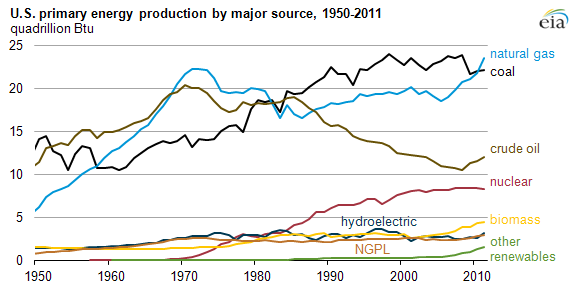
Energy Perspectives: For most fuel sources, domestic production has been increasing

In 2011, the United States produced about 78 quadrillion Btu (quads) of energy, more than at any point in the nation's history. More than three-quarters of this energy production came from nonrenewable fossil fuels: coal, natural gas, crude oil, and natural gas plant liquids. Despite rising production, the United States was a net energy importer, consuming more than 97 quads of energy in 2011.
The 60.6 quads of domestic fossil fuel production set a record, exceeding the previous peak of 59.3 quads in 1998. Of those fuels, natural gas surpassed coal as the most-produced fuel with 23.5 quads compared to coal's 22.2 quads. Production of crude oil, which experienced a long decline from 20.4 quads in 1970 to 10.5 quads in 2008, rose to almost 12 quads in 2011. Natural gas plant liquids (NGPL), which are distinct from 'dry' natural gas, rose to their highest level of 2.9 quads.
Other fuels also experienced record production levels in 2011. Biomass, which includes wood and wood-derived fuels, biomass waste, and biomass inputs to the production of ethanol and biodiesel, increased to 4.5 quads. Other nonhydroelectric renewable energy increased to 1.6 quads, mostly from wind (1.2 quads), with the balance from geothermal and solar-photovoltaic.
The other fuel sources remained at their recent product levels: nuclear electric power contributed 8.3 quads, maintaining its position as the nation's largest nonfossil fuel energy source, and hydroelectric power contributed 3.2 quads.
Time series for several energy production characteristics, along with details about data collection and conversion, are available in EIA's Annual Energy Review.
Tags: biomass, coal, crude oil, liquid fuels, natural gas, nuclear, production/supply, renewables